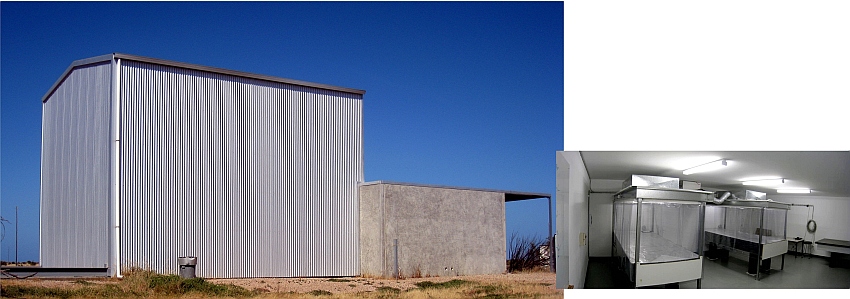|
|
Buckland Park Lidar Facility
The Atmospheric Physics Group in collaboration with the Optics and Photonics Group at The University of Adelaide is setting up a new lidar facility at Buckland Park. The aim is to measure atmospheric temperature, wind and dynamical processes with high spatial and temporal resolution from 10 to 110 km altitude.
Investigating the middle atmosphere by lidar is a well established method and utilised at many sites around the world. However, these sites are predominately in the northern hemisphere and there are very few lidar stations in the southern hemisphere. In particular the southern subtropics are important as there is significant demand for measurement with high spatial and temporal resolution. This facility is the first of its kind in Australia and at a unique location in the southern hemisphere, 35° S 138° E.

Lidar building with telescope shed and laser lab
Technical Propose
First stage of project:
- Lidar building is already finished
- We expect to move our equipment soon from the laboratory at Uni into the Lidar building at BP
- The development of a in-house diode pumped power laser (@532 nm) is in progress
- A one meter mirror is ready to be deployed as receiving telescope
- We will use a two channel data acquisition system to derive temperatures from Rayleigh backscatter in altitudes from 30 to 60 km
- Deploy the coherent laser radar (CLR) operated by the Optics and Photonics Group (see CLR project)
Second stage of project:
- Extend the altitude range down to 10 km by applying additional Rotational Raman acquisition channels
- Extend the altitude range up to 90 km by improving the 532 nm laser
- Apply a second laser system to probe the Sodium resonance line (see guide star and Sodium lidar project) to derive temperatures in a altitude range from 75 to 110 km
- Combined Rotational Raman, Rayleigh and Resonance measurements
- Continuous observation from 10 to 110 km on a regular basis
Scientific Propose
- Study the thermal structure at 35° S covering the troposphere, stratosphere and mesosphere (10-110 km)
- Study chemical and dynamical processes in the Sodium layer (75-110 km)
- Study dynamical processes through the atmosphere such as tidal, planetary and gravity waves
- Compare these observations with co-located measurements from radar and passive optical instruments
- Intercomparison of these local observations with Satellite and Model results
Publications
A new lidar facility to investigate the middle atmosphere over Buckland Park, Australia, 35° S
- Conference publication 2010, Reviewed and revised papers presented at the 25th International Laser Radar Conference, ISBN:978-5-94458-109-9, pp 136-139, Saint Petersburg, Russia.
- Poster presentation 2010, Presented at the CEDAR (Coupling, Energetics and Dynamics of Atmospheric Regions) workshop, University of Colorado, Boulder, USA.
Laser remote sensing for a better understanding of the middle atmosphere
Personnel
Prof. Iain Reid
Dr. Jens Lautenbach
Dr. David Ottaway
Dr. Andrew MacKinnon
A/Prof. Peter Veitch
|


